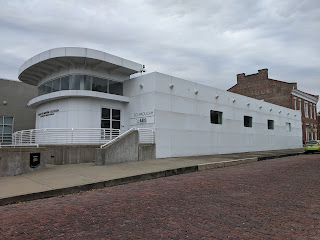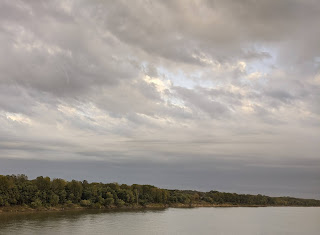
Last October, after a very peaceful couple of weeks at our favorite beach on the Florida Panhandle and a couple of days exploring civil rights sights in Montgomery, Alabama, we headed home to Denver. IF we had wanted to go directly, it would have meant a 1,450-mile drive. Going from Point 'A' to Point 'B' without stopping at several places on the way would have been too simple for us of course! Instead, we decided to drive 1,000 miles almost due north to visit our daughter's family in Chicago and then another 1,000 miles almost due west home to Denver.
Before our intended stop for the night in Metropolis, Illinois, we were lucky to discover the most exciting rest area on any interstate yet located just over the border in Tennessee. The state was known as the Soundtrack of America because of the country music capital of Nashville.
Historical plaques and buildings referred to the Civil War in the state. Jumping ahead almost one hundred years, we read the first section of the Tennessee interstate was opened in November of 1958 after legislation was passed to create the interstate system in 1956.
Somehow, Steven and I neglected to realize that Nashville was the state capital as we drove right through without stopping to look at the statehouse. We had been to Music City a couple of times but hadn't been interested then in the state capitols. We vowed to stop there next year, i.e. this year now, but once again we won't have time to stop as we hightail it from Florida up to Chicago in two very long days. Bummer!
Before continuing on to Metropolis, we detoured to Paducah, Kentucky to see several sights of interest. One was The National Quilt Museum that opened in 1991 in Paducah to honor and promote quiltmakers. The town mayor subsequently proclaimed Paducah as Quilt City, USA. As we had arrived too late to tour the museum, we were left just enjoying the pretty windows that looked like quilts. Darlene: I'm sure you'd love to see the museum someday.
On the museum grounds were the On the Trail of Discovery sculptures by George Lundren. They referred to explorers Lewis and Clark encountering Indigenous people who assisted them as they made their trek westward. Lundren used artistic license by adding Sacajawea coins and Paducah to the map held by Clark.
In what surely must be the best deal ever, Clark purchased 37,000 acres of land, including the future site of Paducah, for just $5 in 1827! The land had been part of a Revolutionary War grant to Clark's brother.
The reason we'd chosen to visit Paducah was that twenty blocks of the city's downtown had been designated a historic district and listed on the National Register of Historic Places.
Market Square:
Another historical plaque noted that Clara Barton, the organizer of the American Red Cross, arrived in Paducah in 1884 to give aid to the victims of the Ohio flood in the city.
In 1996, Louisiana muralist Robert Dafford and his team began the Paducah Wall to Wall mural program on the floodwall in downtown Paducah. More than 50 murals were painted addressing numerous subjects, including Indigenous history, industries such as river barges and farming, local Black heritage, and steamboats.
We caught a glimpse of the Ohio River through the opening between the murals.
Some of the murals had extensive descriptions. This one, for instance, honored the Paleo Indians who lived in what is now the lower Ohio Valley area near the end of the last Ice Age, about 13,000 years ago. The Paleo Indians, also called Big Game Hunters, were described as nomadic hunters and gatherers who made distinctive fluted projectile points.
Around 3,000 years ago, Indians of the Archaic Tradition, a group totally new to me, were the first in this area to begin domesticating plants that were then traded over long distances for exotic resources. They were also the first to live in permanent villages and bury their dead in cemeteries.
Paducah's historic riverfront was where the Tennessee River flowed into the Ohio River. In 1779, George Clark's small army landed to prepare for the defeat of the British in nearby Illinois. Colonel John Donelson in 1780 landed 30 boats with 30 families that had floated down the river from east Tennessee. General Ullyses S. Grant landed here in 1861 to occupy Paducah for the Federal Union during the Civil War.
We then strolled along the other side of the floodwalls where we learned of the importance of the harbor. The deep protected water between Owens Island in the center of the river and the Kentucky shore was a major base for commercial navigation throughout the city's history. Every type of barge and boat used in the Mississippi Valley was "built, repaired, manned, and supplied here." As it was an ice-free winter harbor, steamboats from northern rivers used the Paducah Harbor.
I can't remember the last time I'd seen a tugboat! It was fun as I recalled reading stories to our children of tugboats when they were young.
This part of the mural symbolized the festivities that took place on the state's bicentennial on the riverfront where the city's history originated.
I hadn't known that Paducah was also known as Atomic City after the US Atomic Energy Commission approved the former Kentucky Ordinance Works location as the site for a new facility in the country's growing nuclear production complex in 1950. In just four years, the local population doubled as the construction workforce arrived and school enrolment increased from 8,000 to 12,000. The mural commemorated the thousands who "worked for better plants, a stronger community, and a higher quality of life."
The Paducah Gaseous Diffusion Plant is the only uranium enrichment facility in the country and a global supplier of enriched uranium for electricity production.
The steam engine at the end of one of the floodwalls was presented to the city in 1963 to perpetuate memories of the days of the steam locomotive. We read that visitors coming by boat to Paducah in the early part of the last century would have been greeted by the hustle and bustle of the riverfront lined with hotels, warehouses, iron foundries, lumber yards, and other businesses connected to the river.
These were just some of the murals! They certainly deserved more time than we had that day after driving more than 400 miles and still hadn't reached our stop for the night.
This mural honored the city's Black history: the August 8th Emancipation Celebration is held annually in Stuart Nelson Park that was named for a commissioned officer in WW I who marched with Gandhi in India and Martin Luther King, Jr. in Atlanta; Burks Chapel AME ran the first school for Black children around 1878; the West Kentucky Technical College was founded in 1909 to train Black teachers and, by 1938, became the third-largest Black junior college in the country.
Having already viewed Market Square, this mural looked very familiar!
This mural was my first opportunity to see an image of a horse-drinking fountain!
When Paducah-McCracken County was known as the strawberry capital of the world in the early 1940s, schools excused students to pick berries. Entire families also participated in berry picking. Freight cars carried thousands of crates of strawberries across the country. A 'Strawberry Queen' was chosen to head the parade on Broadway, Paducah's main street.
I could appreciate how the fabulous Wall to Wall murals, the National Quilt Museum, and other cultural initiatives had contributed to having Paducah declared a UNESCO Creative City of Crafts and Folk Art in 2013.
Another view of the Market Square building as we then walked around the area:
Colorful tiles adorned the Market Square Theater.
Kirchhoff's Bakery was established in 1873 on Market House Square and was one of the buildings placed on the National Register. Too bad it was closed as I would have been happy to patronize them!
I liked how businesses like Max's Brick Oven Cafe and others had 'adopted' planters out front for all to enjoy. I don't remember seeing that before.
Michiel: Did you note how seamlessly I was able to work in both granddaughters' names in this post? Not sure that will ever happen again!
It was very unusual seeing a single-story City Hall.
Hotel Metropolitan was built in 1906 and was in the process of theoretically undergoing a very necessary multi-phase renovation. I intentionally used the word 'theoretically' because the sign advertising the renovation looked almost as old as the hotel itself!
The statue honored Chief Paduke of the sub-tribe of the Chickasaw Indigenous tribe who lived and hunted in this area until 1818. The statue wasn't meant to be an accurate reflection as the sculptor combined features of various Indigenous tribes in his work. Once Clark purchased the land he named the town in the chief's honor.
Heading over an incredible bridge from Paducah to Metropolis in Illinois, home as you would know of Superman if you were ever into comics!
A teaser for the next post!
Next post: Think you know already!Posted on August 13th, 2021, from our rental cabin at Grayton Beach State Park where we are so, so happy to be ensconced for another week as long as Tropical Storm Fred doesn't make an unwelcome appearance here on Florida's Panhandle. Wherever you are, please stay safe and sound.



























































No comments:
Post a Comment